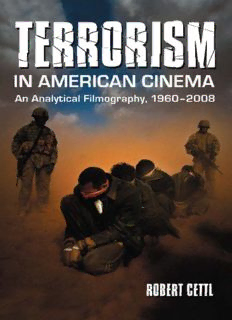
Terrorism in American Cinema: An Analytical Filmography, 1960-2008 PDF
Preview Terrorism in American Cinema: An Analytical Filmography, 1960-2008
Terrorism in American Cinema ALSO BY ROBERT CETTL AND FROM MCFARLAND Serial Killer Cinema: An Analytical Filmography with an Introduction (2003; softcover 2008) Terrorism in American Cinema An Analytical Filmography, 1960–2008 R C OBERT ETTL McFarland & Company, Inc., Publishers Jefferson, North Carolina, and London LIBRARYOFCONGRESSCATALOGUING-IN-PUBLICATIONDATA Cettl, Robert, ¡969– Terrorism in American cinema : an analytical filmography, 1960–2008 / Robert Cettl. p. cm. Includes bibliographical references and index. ISBN 978-0-7864-4155-6 softcover : 50# alkaline paper 1. Terrorism in motion pictures—Catalogs. 2. Motion pictures—United States—Catalogs. I. Title. PN1995.9.T46C48 2009 791.43'6556—dc22 2009034738 British Library cataloguing data are available ©2009 Robert Cettl. All rights reserved No part of this book may be reproduced or transmitted in any form or by any means, electronic or mechanical, including photocopying or recording, or by any information storage and retrieval system, without permission in writing from the publisher. On the cover: A scene from the 2007 documentaryTaxi to the Dark Side— facing blinding dust clouds, the U.S. Army prepares to transport detainees by helicopter to Al Qaim base for questioning after being captured during Operation Steel Curtain, Iraq, November 21, 2005 (ThinkFilm/Photofest) Manufactured in the United States of America McFarland & Company, Inc., Publishers Box 611, Jefferson, North Carolina 28640 www.mcfarlandpub.com For Huiling in memory of the Dreamlife This page intentionally left blank Table of Contents Preface 1 Introduction 3 THE FILMOGRAPHY 17 Notes 297 Bibliography 301 Index 303 vii This page intentionally left blank Preface The impetus for this book grew out of the observation that during the immediate aftermath of 9/11 and the War on Terror, few major terrorist films were released even though in the previous decade terrorism had generated numerous pop culture film fan- tasies. Indeed, the real events of 9/11 put the cinema of terrorism in much the same sit- uation as the war movie during the Vietnam War: It was only after the Vietnam War was over that American film was ready to tackle the issue and its socio-cultural ramifications. And when American film was finally ready to do so, it had a genre with some forty years of development to draw upon, deconstruct and re-envision. The events of 9/11and the entry into the American lexicon of such terms as War on Terror, waterboarding and collateral damage forced the USA to address terrorism as national trauma, a turning point in the nation’s history. Terrorism was thus too serious for popular entertainment. However, as the War on Terror President George W. Bush lost control of the Senate and became a proverbial lame duck soon to be replaced by Demo- crat Barack Obama, American cinema rallied behind the terrorist film genre and re- invented it as the most dynamic, exciting and relevant means of socio-political criticism in contemporary American cinema. It was not only the mechanics of terrorism that infiltrated these films but the criti- cism of what was increasingly seen as the circumvention of Constitutional ideals by a cabal comprised of George W. Bush, Dick Cheney and Donald Rumsfeld. Just what this Repub- lican, Christian government had done to American ideals of democracy became the sub- ject driving a sudden wave of post–9/11terrorist movies. Yet, the impressive thematic and stylistic coherence within this body of work owed to what had evolved pre–9/11as a dis- tinct genre in American film—the cinema of terrorism—and addressed its legacy in inter- esting ways. The development of the cinema of terrorism as a genre in American film—its his- torical contexts, thematic bases, narrative structures, ideological ramifications, political commentary and psycho-analytic intent—is the subject of this book, the first evaluation of the cinema of terrorism as a genre and an analytical filmography of every major, minor and obscure terrorist film comprising the genre pantheon. It is the author’s hope that this study succinctly explores a genre that due to the events of 9/11in transfiguring the Amer- ican social and political consciousness uniquely offers a coherent exploration of the devel- opment of what now comprises the modern American political psyche. 1
Description: